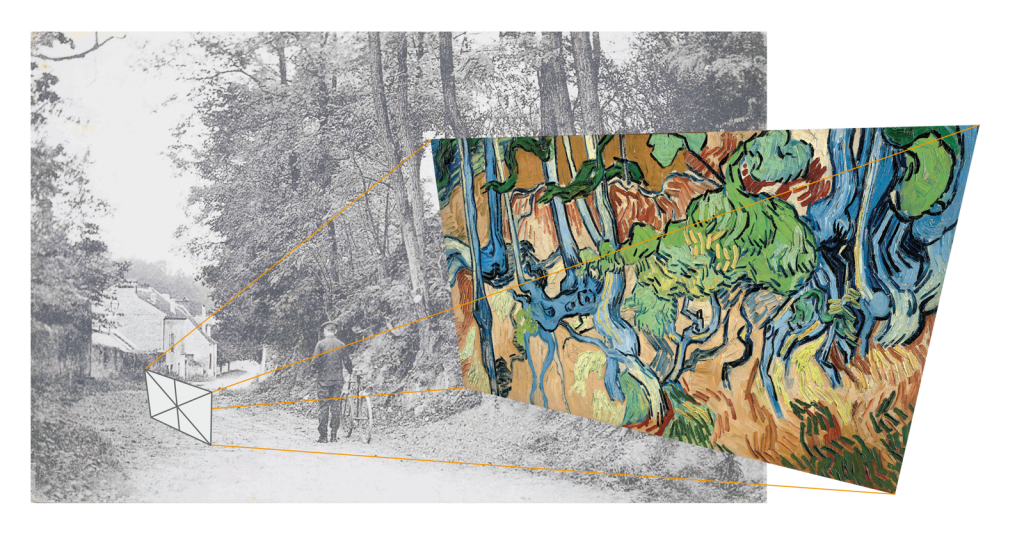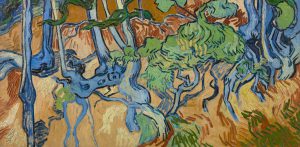Encyclopedic in their comprehensive coverage of themes and locations, postcards often hold clues about the people and places of the past.
That’s exactly what happened this summer in France, where the exact location that Dutch post-impressionist painter Vincent van Gogh produced his final masterpiece, Tree Roots, was discovered after 130 years.
Suffering from depression exacerbated by poverty, malnutrition, overwork, insomnia and alcohol, Van Gogh voluntarily admitted himself to the Saint-Paul-de-Mausole psychiatric asylum on May 8, 1889. Five months earlier, he famously severed his left ear with a razor following an altercation with his friend and fellow painter Paul Gauguin. Van Gogh eventually left the asylum in May 1890 to live in Auvers-sur-Oise, a suburb on the outskirts of Paris, France.
On July 29, 1890, just a few weeks after finishing his last work, Van Gogh shot himself in the chest with a revolver. He died 30 hours later at the age of 37.
‘A REMARKABLE DISCOVERY’
Wouter van der Veen, scientific director of the Institut van Gogh in Auvers-sur-Oise, recently came across a postcard dating from the early 1900s.
Featuring a familiar-looking scene with tree trunks and roots growing on a hillside, the postcard was immediately submitted to senior researchers at Amsterdam’s Van Gogh Museum. The researchers also consulted a dendrologist (someone who studies wooded plants) named Bert Maes, who specializes in historical vegetation.
Based on Van Gogh’s working habits and a comparative study of the painting, postcard and current condition of the hillside, the experts concluded it is “highly plausible” the rural hillside is the correct location.
“Every element of this mysterious painting can be explained by observation of the postcard and the location – the shape of the hillside, the roots, their relation to each other, the composition of the earth and the presence of a steep limestone face,” said Van der Veen, who also documents his discovery in a book, Attaqué à la racine (Attacked at the Roots in English), which is available for free (in French) via his website, bit.ly/2ExIfpA.
Teio Meedendorp, one of the Van Gogh Museum researchers, agreed the location identified by Van der Veen is “highly likely to be the correct one, and it is a remarkable discovery.”
“That this is his last artwork renders it all the more exceptional, and even dramatic. This area had already been documented by Van Gogh in other paintings. He must often have passed by the location when going to the fields stretching out behind the castle of Auvers, where he painted several times during the last week of his life and where he would take his own life.”

Van Gogh’s 1887 oil painting, Self-Portrait, is one of more than 40 self-portraits produced by the iconic artist from 1885-89.
This May, once France lifted its initial COVID-19 lockdown (and several months after the deltiological discovery), Van der Veen visited the site to verify his theory. The largest tree trunk from the painting is still present and recognizable, and it’s just 150 metres from the Auberge Ravoux, an inn in Auvers-sur-Oise where Van Gogh spent the final 70 days of his life.
“The site is also consistent with Van Gogh’s habit of painting motifs from his immediate surroundings,” added Van der Veen. “The sunlight painted by Van Gogh indicates that the last brush strokes were painted towards the end of the afternoon, which provides more information about the course of this dramatic day ending in his suicide.”
On July 28 – almost 130 years to the day of Van Gogh’s suicide – Van der Veen attended a ceremony in Auvers-sur-Oise to reveal where the troubled artist painted Tree Roots, which is in the Van Gogh Museum collection.
In co-operation with local authorities, officials with the Institut van Gogh also erected a protective wooden structure to safeguard the site while allowing public visits.


